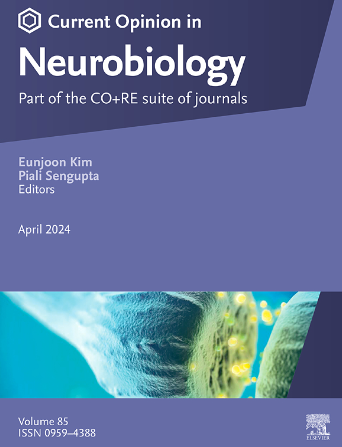The carotid body oxygen sensor
IF 5.2
2区 医学
Q1 NEUROSCIENCES
引用次数: 0
Abstract
Carotid body (CB) chemoreceptor glomus cells sense hypoxia through the inhibition of plasmalemmal K+ channels, which leads to the opening of Ca2+ channels, Ca2+ influx, and neurotransmitter release. The mechanism of O2 sensing and the regulation of membrane ion channels by O2 have remained undefined and a subject of debate. Here, we summarize the molecular pathway that underlies acute O2 sensing in the CB. This process does not rely on a single-molecule O2 sensor expressed in glomus cells but rather on HIF2α-dependent genetically specialized mitochondria that can detect changes in O2 tension, within physiological ranges, and generate biochemical signals that regulate membrane ion channels. The acute O2-sensing pathway in glomus cells could provide new targets for respiratory and cardiovascular pharmacology.
颈动脉体氧传感器
颈动脉体(CB)化学受体球囊细胞通过抑制质浆K+通道感知缺氧,从而导致Ca2+通道开放,Ca2+内流和神经递质释放。O2感知的机制和O2对膜离子通道的调控仍然是一个不明确的话题。在这里,我们总结了分子途径的基础上的急性O2感应在CB。这一过程不依赖于球囊细胞中表达的单分子O2传感器,而是依赖于hif2 α依赖的遗传特化线粒体,它可以在生理范围内检测O2张力的变化,并产生调节膜离子通道的生化信号。血管球细胞的急性o2感应通路可为呼吸和心血管药理研究提供新的靶点。
本文章由计算机程序翻译,如有差异,请以英文原文为准。
求助全文
约1分钟内获得全文
求助全文
来源期刊

Current Opinion in Neurobiology
医学-神经科学
CiteScore
11.10
自引率
1.80%
发文量
130
审稿时长
4-8 weeks
期刊介绍:
Current Opinion in Neurobiology publishes short annotated reviews by leading experts on recent developments in the field of neurobiology. These experts write short reviews describing recent discoveries in this field (in the past 2-5 years), as well as highlighting select individual papers of particular significance.
The journal is thus an important resource allowing researchers and educators to quickly gain an overview and rich understanding of complex and current issues in the field of Neurobiology. The journal takes a unique and valuable approach in focusing each special issue around a topic of scientific and/or societal interest, and then bringing together leading international experts studying that topic, embracing diverse methodologies and perspectives.
Journal Content: The journal consists of 6 issues per year, covering 8 recurring topics every other year in the following categories:
-Neurobiology of Disease-
Neurobiology of Behavior-
Cellular Neuroscience-
Systems Neuroscience-
Developmental Neuroscience-
Neurobiology of Learning and Plasticity-
Molecular Neuroscience-
Computational Neuroscience
 求助内容:
求助内容: 应助结果提醒方式:
应助结果提醒方式:


